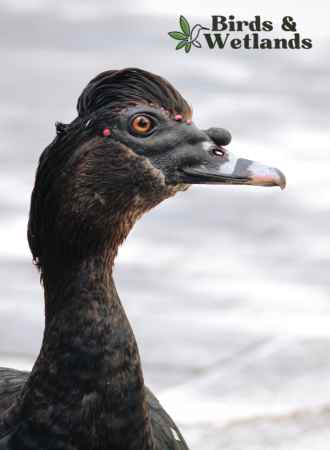The Mexican duck (Anas diazi) is a dabbling duck native to Mexico and parts of the southwestern United States, making them North American birds.
These ducks are also known as Mexican mallards due to their resemblance to the female mallard.
Scientific Name: Anas diazi
Height: 51–56 cm
Wingspan: 88 inches (2.24 meters).
Weight: 24 pounds (10.9 kg)
Physical Description of the Mexican Duck

The Mexican duck is a medium-sized duck with a dark brown head and breast, grayish-brown flanks, and an olive-brown belly. It has a blue speculum bordered by white on the wings, which is visible in flight.
Both sexes have similar plumage, but the males have a brighter yellow bill than the females. The bill color is often used to distinguish between genders.
As part of the Mallard complex, which also includes the American black duck (Anas rubripes), mallard (Anas platyrhynchos) and mottled duck (Anas fulvigula), the Mexican duck looks similar to the female mallard but with slightly darker plumage. It gained species status and became its own species.
Listen to the Mexican Duck
Migration & Range of the Mexican Duck
The Mexican duck has a breeding range limited to the interior of Northwestern and Central Mexico, from Sonora and Coahuila as far south as Michoacán. This species is rarely seen in the United States outside of this region.
A hundred ducks are dispersed across Arizona, southern New Mexico and Texas. All the birds were believed to have originated from the captive ducks that were released in the 1960s and 1970s by the New Mexico Fish and Game Department.
Unlike many other species, the Mexican duck is not a migratory bird and tends to stay in the same area throughout the year. It can thrive in various habitats, including wetlands, lakes, and urban areas. Its flexibility allows it to find the food resources to survive year-round without undertaking long migratory journeys.
Despite its non-migratory behavior, the Mexican duck can still handle seasonal movements. For example, the Mexican duck may move to different areas within its range to take advantage of seasonal food sources or to avoid harsh weather conditions.
However, these movements are typically much shorter in terms of distance and are often confined within limited local areas than other ducks’ long-distance migrations.
Habitat

Mexican ducks prefer to inhabit shallow lakes, marshes, ponds, and rivers, where they can both find food and shelter. Additionally, they can be discovered in flooded agricultural fields and other seasonal wet areas. These birds are typically solitary but may occasionally congregate in small groups.
As they prefer warmer climates with fewer temperature extremes, Mexican ducks are more likely to be spotted in the early morning or late evening when temperatures are cooler. During dry seasons, many birds flock near lakes and other bodies of water. Most of the flocks break and spread to other areas during the rainy seasons.
For protection against large predators such as hawks and owls, they frequently seek out dense vegetation in their natural habitat. When resting or feeding on aquatic invertebrates, Mexican ducks seek out dense vegetation, such as tall grasses, for camouflage along the banks of bodies of water.
Feeding Habits & Diet of the Mexican Duck
The Mexican duck is a dabbling duck that primarily feeds on the water’s surface. It feeds on small animals such as insects, dragonflies, and aquatic invertebrates like freshwater shrimp.
In addition to these animal foods, Mexican ducks consume plant matter from the surface or shallow depths of the water, such as small seeds, plants, and weeds growing near shorelines.
These ducks often forage in flocks and may use their bills to stir up the sediment on a pond or lake floor to expose their prey.
Due to its wide range of feeding habits, this species is quite adaptable to finding sustenance in different habitats throughout Mexico and the southern parts of the United States. They may also feed on human-provided sources, such as crops in agricultural areas or waste-associated food sources like garbage dumps.
Nesting & Mating Habits of the Mexican Duck

The Mexican duck is a bird that mates for life. Male ducks perform special displays to win a mate, such as stretching their necks and nodding their heads. Once they have chosen a partner, they stay with them for the rest of their lives.
The breeding season depends on the weather and water conditions.
The wild Mexican duck builds its nest in wet areas with shallow water and nearby plants. It is often located about 50 yards away from the nearest water.
The nest is a shallow bowl on the ground made of dead reeds, sedges, grasses and other plant material that the hen builds to keep her eggs safe and warm. The nest is nestled in grasses, rushes, or sedges.
When the female Mexican duck is ready to lay eggs, she will lay up to 8 white eggs with reddish-brown spots in shallow water near plants for protection. The eggs take 21-25 days to hatch. Only female Mexican ducks incubate the eggs. Male Mexican ducks join other males to molt.
About half of the baby Mexican ducks survive due to predators or other environmental challenges such as extreme weather or a lack of food.
Once the eggs hatch, the baby ducks, called ducklings, stay close to their parents for protection until they are old enough to take care of themselves, around eight weeks old. If the adult ducks lose their mate, they may choose to mate with another partner instead of staying alone.
Interestingly, Mexican ducks engage in extensive hybridization with the mallards.
Mexican Duck Threats & Conservation
The Mexican duck is listed as Least Concern by the IUCN. Previously, it was listed as an endangered species by the U.S. Fish and Wildlife Service. The population is experiencing a slow but marked decline in recent years.
However, the species faces threats from hunting and habitat destruction. Hunting for food or sport has been one of the major contributors to its decline in numbers. Human activities have drastically reduced available food sources and suitable breeding grounds for ducks.
Several conservation initiatives have been launched at a national and international level to protect the Mexican duck. Currently, there are laws protecting this species from hunting in Mexico. The government also provides funds for wetland conservation projects which benefit the duck by providing undisturbed habitats where they can feed and breed safely.
Mexican Duck Hunting

Even though Mexican ducks are migratory waterfowl, their presence in the contiguous United States has been exceedingly uncommon in recent decades. Recent reports indicate that some of these birds pass through U.S. borders for brief periods during the winter, but they may need to stay longer to provide consistent hunting opportunities.
Key Points
- The Mexican duck is a dabbling duck native to Mexico and parts of the southwestern United States.
- Mexican ducks are closely related to mallards, American black ducks and mottled ducks. They are now a separate species.
- The male and female Mexican ducks share the same appearance to the female mallard ducks with a bright yellow bill.
- These dabbling ducks prefer to inhabit shallow lakes, marshes, ponds, and rivers. They can also be found in urban areas and flooded agricultural fields.
- The Mexican duck (Anas platyrhynchos diazi) feeds on small animals and plant matter from the surface or shallow depths of the water. They may also eat human-provided sources of food.


